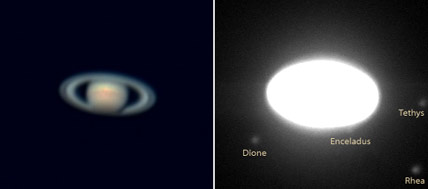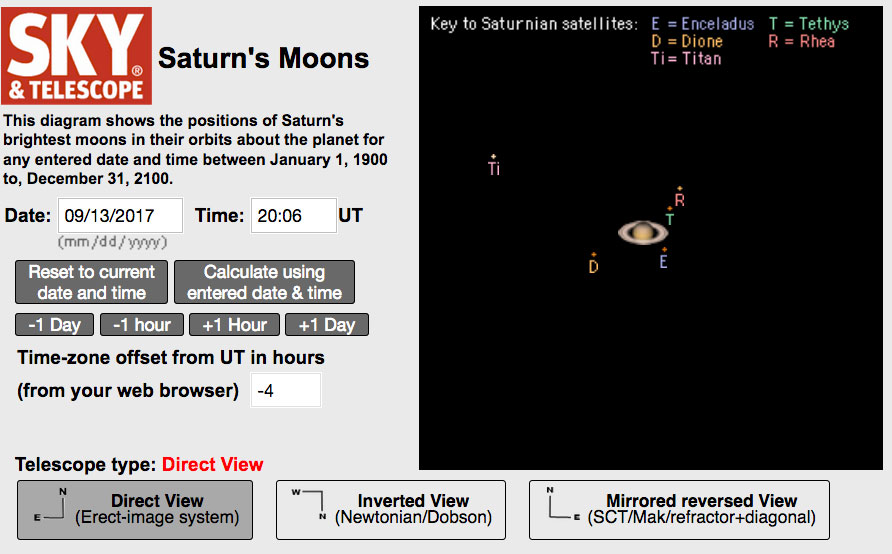Launch our interactive Saturn's Moons observing tool!

S&T: Richard Tresch Fienberg
Anyone who looks at Saturn through a telescope will notice at least one and possibly several pinpoints of light glimmering near the planet. Even a 60-millimeter (2-inch) telescope will show Saturn's brightest moon, Titan, which shines around 8th magnitude and has a smoggy atmosphere that gives it an orange cast. A 15- or 20-centimeter (6- or 8-inch) scope may reveal up to four fainter satellites closer to the planet.
But how can you distinguish them from background stars, and how can you tell which moon is which?
That's where our interactive observing tool comes in!
For any date and time between 1900 and 2100, it shows the positions of Titan and four other bright moons: 10th-magnitude Rhea, Tethys, and Dione, and 12th-magnitude Enceladus. Moreover, the tool can match the view through your telescope's optical system whether it shows the sky with north up or south up, and either correct-imaged or mirror-reversed.
How to Use the Saturn's Moons Observing Tool

Sky & Telescope's Saturn's Moons observing tool, which will open in a new browser window, shows the positions of the planet's brightest satellites, Titan, Rhea, Dione, Tethys, and Enceladus, for any date and time from January 1900 to December 2100. At upper left is the date and time; when it opens, these are initialized to the present (as determined from your computer's clock).
Change the date and time by entering new values in the boxes and clicking the dark gray Recalculate button. Or click on the buttons in the next row to step backward or forward in increments of 1 day or 1 hour. Our Saturn's Moons tool uses Universal Time (UT); beneath the time buttons, the tool shows what it thinks is the offset between UT and your local time, based on your computer's current settings.
At upper right is a diagram showing the positions of Titan, Rhea, Dione, Tethys, and Enceladus with respect to Saturn and its rings. Below the time buttons and the graphic are three buttons you can use to change the orientation of the diagram to match the view in your telescope.
- "Direct view" puts celestial north up and celestial east to the left; the routine opens in this orientation, which is the one used in star atlases.
- "Inverted view" puts south up and west to the left, matching the view seen in a Newtonian reflector in the Northern Hemisphere.
- "Mirror reversed" puts north up and west to the left, matching the mirror-image view in most catadioptric (mirror-lens) and refractor telescopes used with a star diagonal.
Launch S&T's Saturn's Moons observing tool.
Find more information about observing Saturn here: An Observing Guide to Saturn. If you see any problems with this tool, or any of our interactive tools, please send an email to [email protected].
 8
8








Comments
Lawrence Geary
April 25, 2014 at 5:52 pm
Please make Android versions of your apps. One half of the mobile devices out here are NOT Apple IOS devices.
You must be logged in to post a comment.
Stub Mandrel
April 27, 2014 at 10:26 am
Please make an app to help me find the PC versions of your utilities 🙂
Seriously, I have been using eth jupiter on for a good while.
You must be logged in to post a comment.
Raymond
June 7, 2014 at 12:55 am
It would be nice if Mimas and Iapetus were added to the mix. No need to change the scale, Iapetus could just be shown only when sweeping above or below the planet.
You must be logged in to post a comment.
jasinthebox
June 17, 2017 at 4:29 am
For the life of me, I couldn't get any link to open the Saturn moon app on PC - just links to the app store. If anyone else is having this problem here is the link for PC:
http://skyandtelescope.org/wp-content/observing-tools/saturn_moons/saturn.html#
You must be logged in to post a comment.
roy
September 7, 2020 at 10:46 am
The Saturn app doesn't work for me.
You must be logged in to post a comment.
Monica Young
September 8, 2020 at 9:56 am
If you're experiencing any trouble with the app, can you email [email protected] with more details? We can help you troubleshoot.
You must be logged in to post a comment.
SJT
June 24, 2017 at 7:37 pm
So from the Southern hemisphere the images as displayed by the tool are simply upside down?
You must be logged in to post a comment.
GraylynMichelle
October 12, 2019 at 7:04 pm
What if the photo, Pale Blue Dot, isn't really the earth being photographed through the rings of Saturn but one of the moons recently discovered. There are so many of them.
You must be logged in to post a comment.
You must be logged in to post a comment.